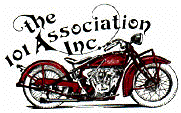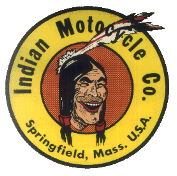Lars, the hollow axle is an integral part of the wheel assembly, and does not need to be undone to effect wheel removal.
The front wheel will come out easily enough, just with removal of the two split pins and large nuts onthe outer side of the fork rockers. There is not usually enough room to just take one off and knock it thru, as the other side nut will snag on the fender brace.
It is best to have the wheel well in the air and well supported for removal, but particularly replacement. best way of lifting the bike by far is to fabricate an arrangement that supports the two front down tube lugs, jacking underneath the engine cases can cause damage unless careful.
Use a soft drift on the axle, as you do not want to damage the threads. The weight of the wheel will make it stiff, and also any slight misalignment in the rockers will make it hard to remove, so take care.
Yes, you will need to deflate the tyre to wriggle it out past the rockers, and also to put it back in, this is why you need to have the bike well supported. A friend to help may be usefull here, when replacing the wheel by myself, I put one foot under the tire to lift it, while I wriggle it past the rockers using both hands.
The rear can be removed With the hinged section up, or past the removable strut on the 28/29 with the bike on the rear stand, but it is far easier to be able to jack the bike up high and after the initial rear movement to clear the brake plate from the frame, drop the wheel straight down. If in a pinch propped up un a milkcrate or similar over a step will give you enough height, Ken, I had to do that on the steps of the cricket pavillion at the Men of Kent Sittingbourne Run one year :).
Remember first to disconnect the rear brake rod and the clamp that fixes the brake plate to the frame tube.
Bear in mind that when replacing the rear wheel assembly as a whole, you need to line the forward arm section of the brake plate ( that anchors to the frame) horizontally past the rear frame rails where they meet the casting, as it will not rotate past the left hand frame rail once the spindle is in.
If you need to change the tyre by the side of the road, probably easiest to find a blanket and lay the bike on its side .
Carl-Erik is correct about the chainguard, it is real pain. If you have a patinated rider bike, not a bad idea to cut it and use a couple of screws and a plate to make a two piece chainguard, this will make wheel removal , chain replacement or sprocket change much easier.
The only sensible way to fit or remove the changuard without damage is to remove the rear wheel first anyway. If you do feel the need to remove it with the wheel in place, you need to remove the right hand footbaord, and brake rod, and tie the brake arm fully forward, and then pull the guard forwrd while twisting it, and rotating the wheel. If you have taped and greased all painted parts in the vicinity, and are brave and do it forcefully in one movement, you may save the paint. More likely, you will strip paint from the chainguard, frame and wheel rim, but the blood shed from your knuckles is a close approximation to Indian Red and will spill so freely that it may cover the damage.


